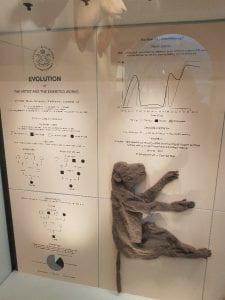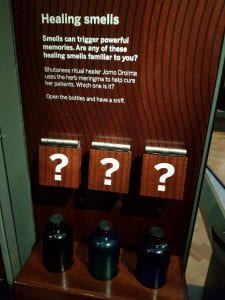Lisa Hinkins, artist, student of MA Curating Collections and Heritage, and Gallery Explainer at Brighton Museum, tells the complex political history of an artefact in the collection.
This is a tale of East-West relations during the Cold War told through a lesser-known design classic, the Garden Egg Chair, on display in Brighton Museum & Art Gallery’s Twentieth Century Decorative Art and Design gallery. The chair reveals relations between East and West Germany in the period now referred to as the Thaw Years (1953-1964).
The post-World War II division of Germany meant that the East of the country inherited the nation’s extensive chemical industry. It gave what was then the Communist-ruled German Democratic Republic (GDR) a great position to compete with new synthetic materials. Inspired by the Space Race, futuristic designs were achieved. With the death of Stalin in 1953, the new Soviet Leader, Nikita Khrushchev was motivated to outdo the West. At the heart of the Communist future was to be higher living standards. Western designs, technologies and materials were viewed as products of a treacherous world but they could be adapted to a Socialist vision.
To compete with the West’s flow of goods crossing the border from West Germany, which was enjoying an economic miracle enabled by US loans, a ‘friendship pipe-line’ connected East Germany (GDR) with Soviet oilfields. The Council for Mutual Economic Assistance permitted GDR factories to supply industrial and domestic plastic products for GDR and the Eastern Bloc, while the Kremlin used oil as a way of propping up the GDR economy in the face of Western competition. GDR leader Walter Ulbricht announced it as ‘an essential element of the socialist cultural revolution’. At the 1958 Chemical Conference he proclaimed, ‘Chemicals Give Bread, Beauty and Prosperity!’
Newer thermoplastics such as polyethylene and polypropylene were preferred products for GDR designers. The possibilities of a new world challenged the dominating official Stalinist aesthetic, which had imitated rococo and Chippendale styles. These were expensive and not suited to mass production, but at the same time Bauhaus-style modern design was viewed as dangerously international, cosmopolitan and a weapon of imperialism. In 1956 Khrushchev proclaimed that he wanted to build ‘better, cheaper, and faster’. The stylistic tide was changing in favour of the Bauhaus-influenced designers. Modernist designers gained control of the aesthetic discourse in East Germany, though many in government found this hard to reconcile. Designers used plastic in unity of form and function. It was manipulated to fit the functional needs of the product, not to cut overheads and increase profit. Most of the GDR population saw plastic as a quality material and a sign of technological progress.

Peter Ghyzczy, Garden Egg Chair. c. 1968. Brighton Museum & Art Gallery. Photograph by Lisa Hinkins. 2018.
Designer Peter Ghyzczy was born in Budapest, Hungary in 1940. After the 1956 political unrest he moved to Vienna, and then to Bonn. He studied sculpture in Düsseldorf and then architecture. After graduating he produced many designs for furniture including the Garden Egg Chair, one of the earliest examples of a hinged chair. The political Thaw did not last and by the early 1960s the ultimate ‘check on freedom’ was the construction of the Berlin Wall in 1961. The East German leader Walter Ulbricht called it an ‘anti-fascist protection barrier’. Ghyzczy’s design defied the barrier with new materials testing carried out in West Germany. Cheaper labour meant the chair could be produced in East Germany. This border-crossing practice was not unique, but it was not publicly acknowledged. The flood of people fleeing East to West threatened the national economy and revealed the GDR’s inability to match the West in the consumer boom. The Garden Egg Chair demonstrates these problems. In the GDR, the chair was unaffordable for the general consumer. Officially one third of production was sold in West Germany, while the rest was for the domestic market and for export.
Expectations raised by the Eastern Bloc were not alleviated when hard currency shops selling Western consumer goods opened in the mid-1960s nor when factories churned out cars and stereos for the domestic market. There were great design accomplishments in the Eastern Bloc, but they did not reach consumers. Production of the Garden Egg Chair ceased after about three years, in part due to its problematic lacquering process. Shortages continued for people living in the Eastern Bloc and promises could not be fulfilled by the communist regime. Cracks also appeared in design discourse with further outbursts from Khrushchev in Moscow and Ulbricht in East Germany on the subject of modern art and ceramics. Some designs were just too modern, even for those in the vanguard of socialism. Ghyzczy moved to the Netherlands in the early 1970s. He developed new ways in fixing glass to metal, resulting in his signature designs for furniture including tables of frameless glass secured with a single brass screw.
After the fall of the Berlin Wall in 1989, followed by the re-unification of Germany in 1990, scholars started to dispel the myths that Western capitalist countries had no contact with Eastern Bloc countries during the Cold War period and the full story of these design exchanges could be told. Brighton Museum & Art Gallery acquired its Garden Egg Chair in 1999. The Twentieth Century Gallery offers a unique setting for a distinctive chair with a complex history.
Further reading:
Crowley, David and Jane Pavitt, eds. Cold War Modern Design 1945-1970. London: V&A Publishing, 2010.
http://www.vam.ac.uk/content/articles/g/the-garden-egg-chair/













